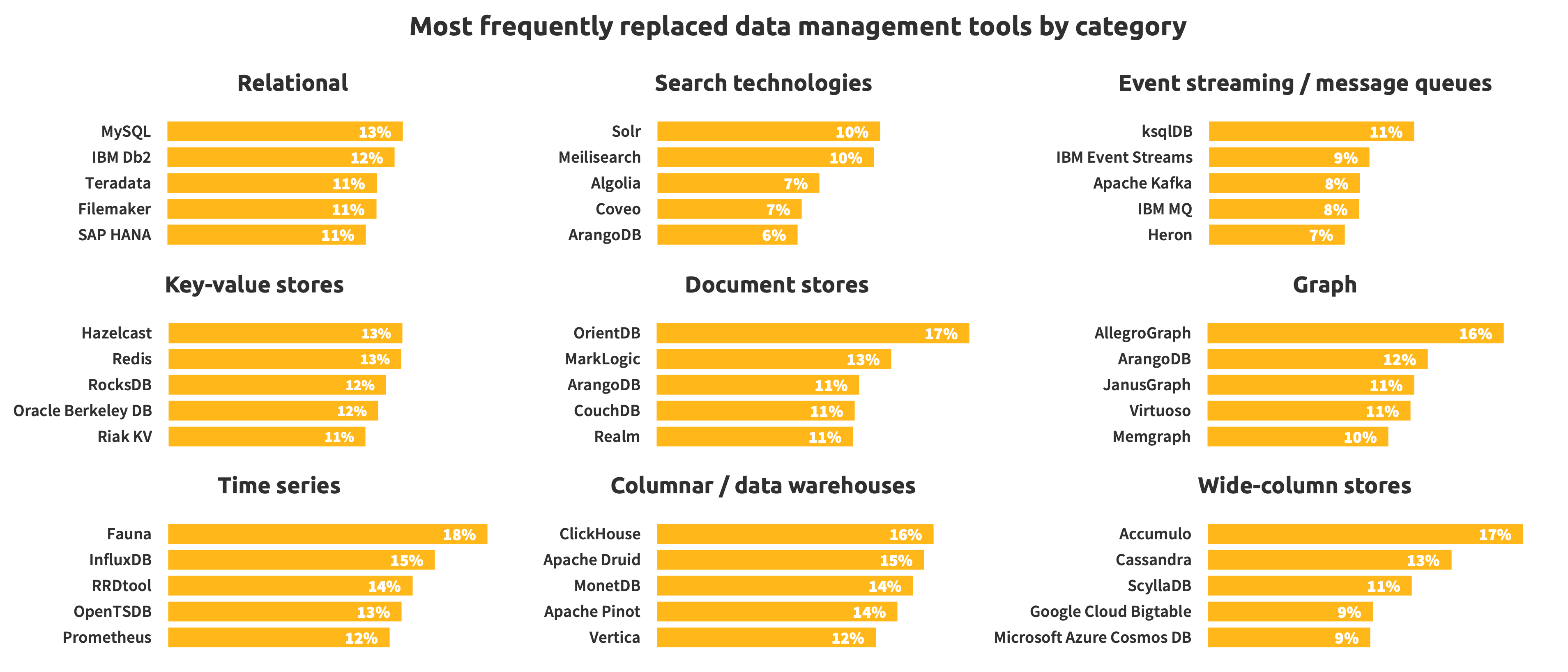Feb 28, 2023
From CTO to shining CTO
We have data on IT practices from 500 experts in the field - but what does any of it mean to a CTO in the know? We asked our own Heikki Nousiainen for insights.

In recent years, companies that have embraced digital native practices have experienced considerable change and growth by placing technology at the heart of their businesses.
In a special in-depth report, commissioned by Aiven and authored by SlashData, we took a numbers-driven look at the the data management landscape at digital native companies - where it was coming from, where it was going, and how it was adapting to changes imposed from the outside and from within.
In the report, we use the identifier fast growth to talk about the overall response to change necessary for companies that are focused on increasing their personnel and tooling. These companies follow a culture that promotes innovation, uses agile operating models, and often relies on predictive analytics to maximize their performance to deliver high quality results.
In the interests of predictions and analysis, then, in this blog our CTO Heikki comments on some of the findings from the report, and expands on what he thinks might be the best approach for a CTO with an eye on the future.
The future of digital native business
One of our report’s key findings was about data management systems–what different professionals in digital native companies thought about them now, and what kind of adoption and usage trends were on the horizon.

As businesses seek to take advantage of the continuous digitization of the modern world, event streaming and message queues are on track to become the second most popular data management systems type among digital native companies.
This point spoke to Heikki, as a CTO. Every company is different, and they need different, tailored solutions to their problems. His advice to his fellow CTOs is simple: familiarize yourself with the tech!
Your team of developers is critical to your success and critical when it comes to making the right choices. Get these people on your side, offer them the best developer experience you can, and then take their advice. They know what they're talking about.
Centralize your experience core, Heikki advises, so you don't end up with a lot of silos within your company, each having no clue what they (or their colleagues in other silos) are doing.
Talk between silos
In reflecting on Aiven’s experiences in this area, Heikki recalled the case we worked on with ADEO.
ADEO group is the third-largest player in the global home improvement market. Founded in 1986 and headquartered in France, ADEO serves more than 450 million customers in 15 countries. ADEO was running thousands of on-premises databases in more than 700 physical stores, which was managed independently. Bringing their operations into a cloud-based, unified model of data without interrupting the day-to-day data operations of a group serving millions of customers was a challenge. ADEO’s developer experience team served a lot of different areas, and needed to deliver database services at a rapid rate.
ADEO started by running just a few Apache KafkaⓇ services, and soon realized how much more easily they could meet their goals with hosted, managed cloud services. They expanded their services to leverage Aiven’s open source services like PostgreSQL, OpenSearch, and more.
The next big thing

56% of respondents are looking to adopt at least one new data management system type in the near future, with those who work for fast-growing companies being 20% more likely to do so than those who work for companies with conservative growth rates.
New data technologies are always important and of interest to developers, and to CTOs this is their bread and butter. It’s all about the criticality of data.
Data forms the basis of all of our decision-making, Heikki says. This is now the main driver: instead of making decisions based on archived reports about what happened yesterday, we now need access to data as it happens, data as a product, data as the source of information telling companies what to do tomorrow, when it used to just be an archived report telling them what they did yesterday.
And data is getting bigger, and more complex, and faster, all the time. Nowadays we can't just capture it all in a relational database and pass info between services. Volumes and velocities are growing, and we need to utilize the technologies best suited for handling the load. It’s the only way to stay ahead of the wave. And the only way to find those technologies is to constantly be on the lookout for them.

Find the people, find the technology
As a CTO, your main focus should be on enabling your teams, more than it is in you personally going out to conventions to check out all the demos and pamphlets. Your developers and other tech experts will find the right tools. You just need to focus on fostering an environment that allows them to explore.
Collect the right skill sets, keep your teams productive, and they’ll tell you which toys work best for your business. And this is where managed databases really shine.
Freeing up your developers’ working hours by taking the chores of database management and maintenance out of their hands can be of immense benefit. Nurture and enable your people, give them access to the productivity tools and the job satisfaction they need, and they will guide your business according to its needs.
Preparing for disaster

Nearly half of those who work for fast-growing companies prioritize service availability and disaster recovery capabilities when adopting data management products.
Hint: if you want to know more about disaster recovery plans and implementation, and how your approach to infrastructure and planning can help your event streaming platform to shine, take a look at our webinar!
The report was right. With modern digital native businesses, Heikki notes, the general expectation is that everything is always on, all systems go all the time–every second counts and your uptime service level agreement (SLA) is critical. It’s a point of crucial importance that CTOs should keep in mind when planning out their approach to system architecture … and it’s something people in fast-growing companies are already thinking about.
Here’s where managed databases help. Again.
With a fully managed setup, you quite simply have more people and teams available to help when the going gets tough. Your developers are free to do their work, and when (not if) things go wrong, the external team you have in place to manage your system is fast to respond–sometimes before your own team is even paged with the issue.
Asking the right questions
Take it from Heikki: choosing solutions comes primarily from a business risk perspective:
Does this meet our needs?
Does it scale?
Is the vendor solid?
Is it highly available (with SLA to confirm it)?
Do we have access to the talent to optimize the tech?
Is it sustainable?
Oh yes, sustainability. Always the afterthought. Well, not for long.
Orange is the new green
The report was quite clear on the impact of sustainability and environmental initiatives. It is growing more and more important, and the time to stop talking and start doing is very much upon us.

In recent years, there has been a growing interest in sustainability by both businesses and consumers around the world. By choosing a DBaaS vendor that is committed to sustainable practices, digital-native companies can ensure that their actions help protect the environment. Our data suggests that there is a high likelihood of this becoming more important when selecting a DBaaS vendor (+62). In fact, this is significantly higher than that of pricing and cost optimisation (+40), suggesting that digital native companies may be more willing to prioritize reducing their environmental footprint over optimizing costs in the future. Interestingly, we find that factors such as company size, growth rate, and location have little impact on the highly positive outlook of sustainability.
At Aiven, we want to challenge ourselves to define what being a socially and environmentally responsible company means, and translate that definition into tangible actions and improvements. We seek to align our social and environmental efforts with our business objectives and key initiatives, and develop both quantitative and qualitative metrics to measure and report on our progress. And we’re not alone.
Heikki wants to leave you with a prediction, and some valuable advice.
Sustainability and carbon neutrality initiatives are happening. They will be mandated all up and down the supply chain, from government regulations and new industry standards all the way through to buyers and end users.
Want to know more?
Our detailed report is available for free now - check out the main findings and all the facts and figures we collected from our digital native friends and colleagues.
Find it right hereTo get the latest news about Aiven and our services, plus a bit of extra around all things open source, subscribe to our monthly newsletter! Daily news about Aiven is available on our LinkedIn and Twitter feeds.
If you just want to find out about our service updates, follow our changelog.
Subscribe to the Aiven newsletter
All things open source, plus our product updates and news in a monthly newsletter.
Related resources

Nov 24, 2022
Is your company experiencing growing pains? It happens. Tech leaders in fast-scaling companies encounter some very specific challenges. Read more to find out.

Feb 24, 2021
With real-time data on the rise, time series databases are more and more in demand and on offer. Read this article to find out how you can choose between them.

Feb 25, 2022
Should you get your database managed? Discover the real costs and benefits of self-hosted vs. managed databases.

